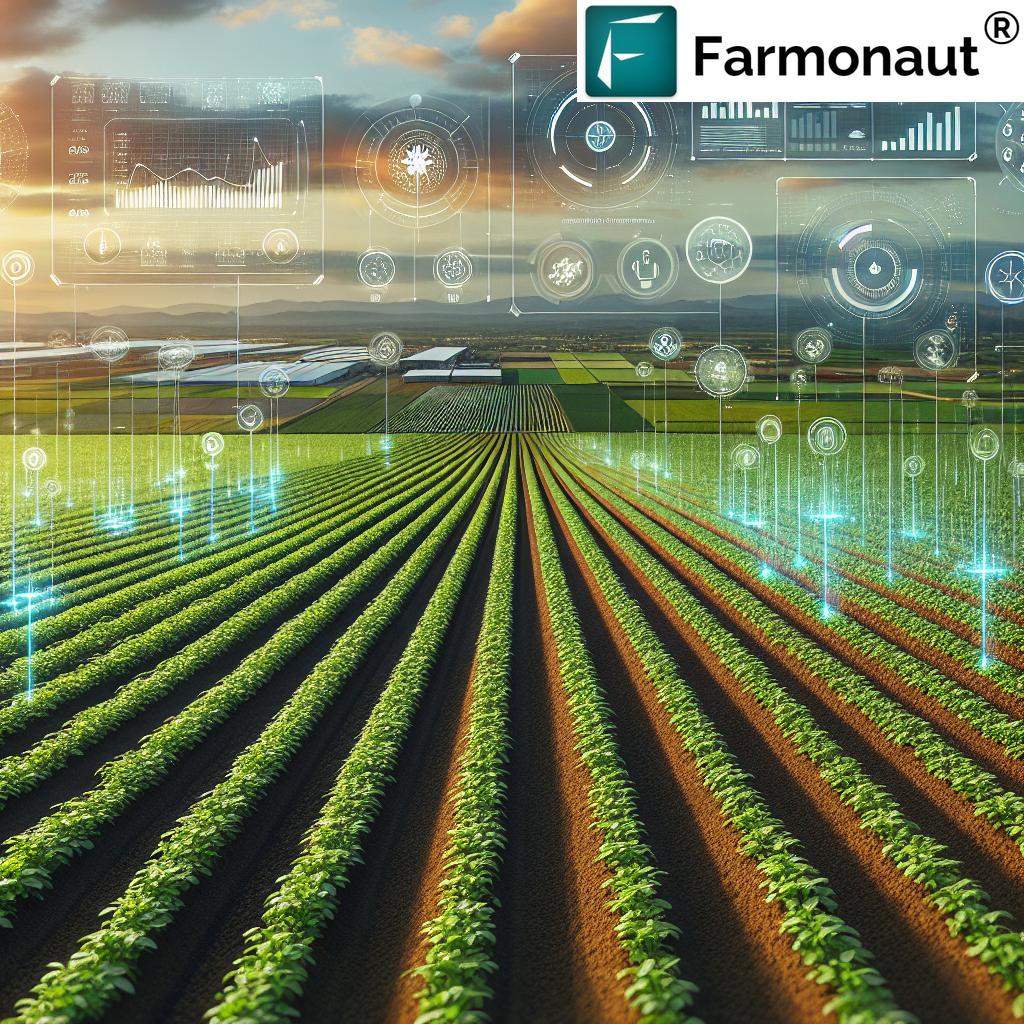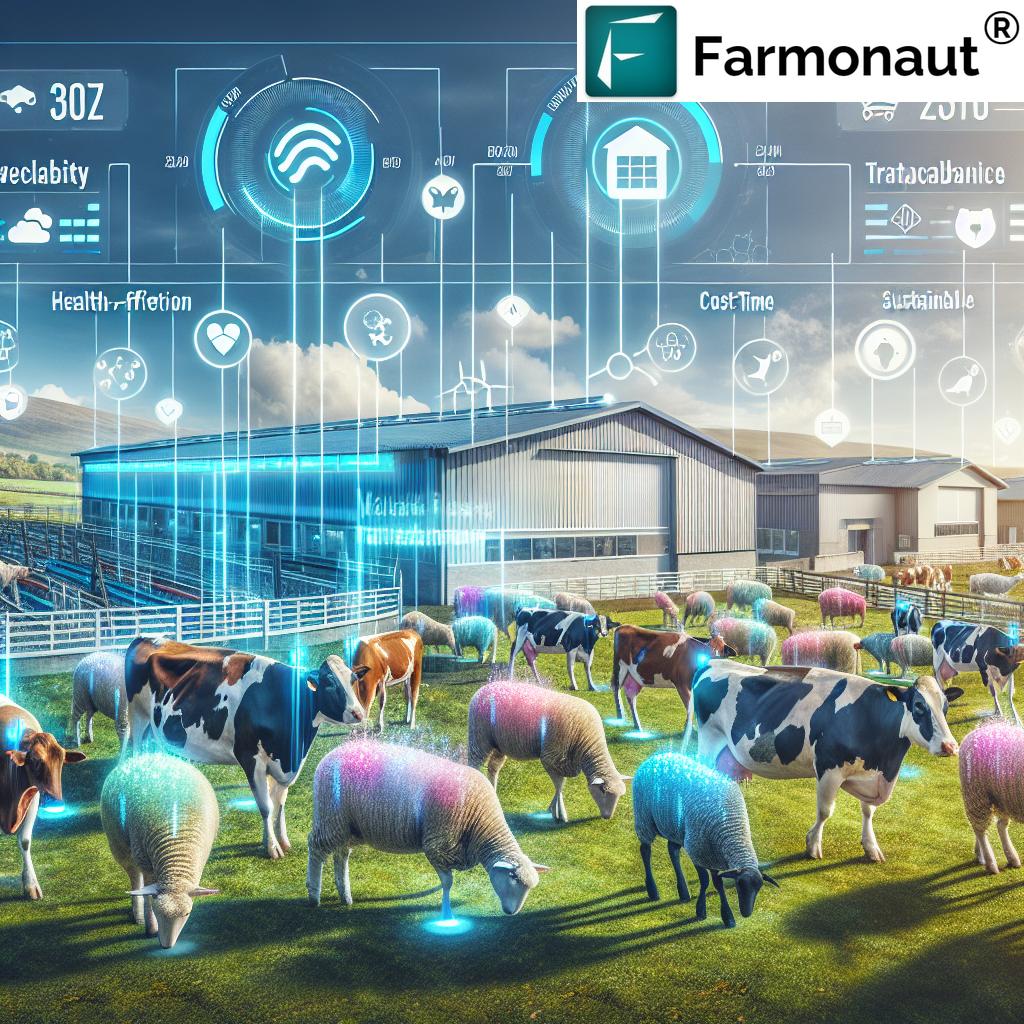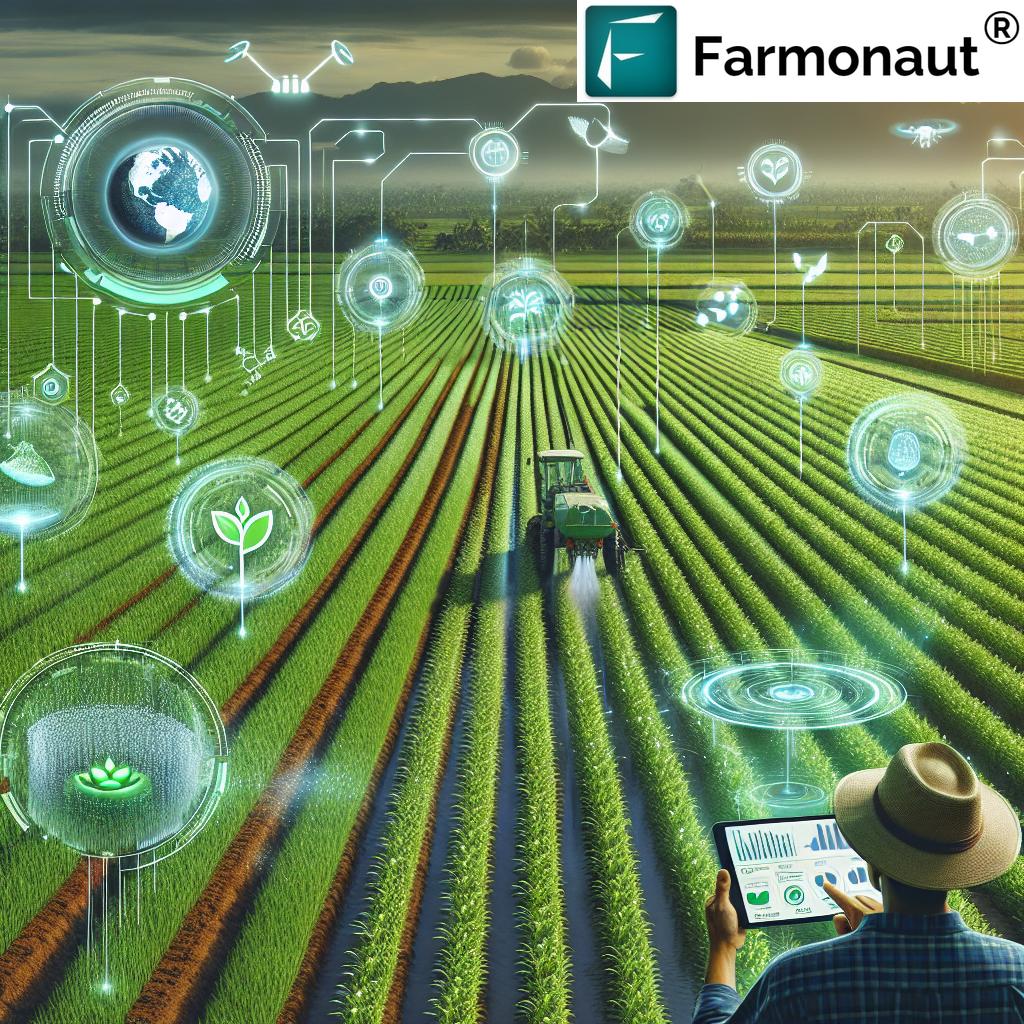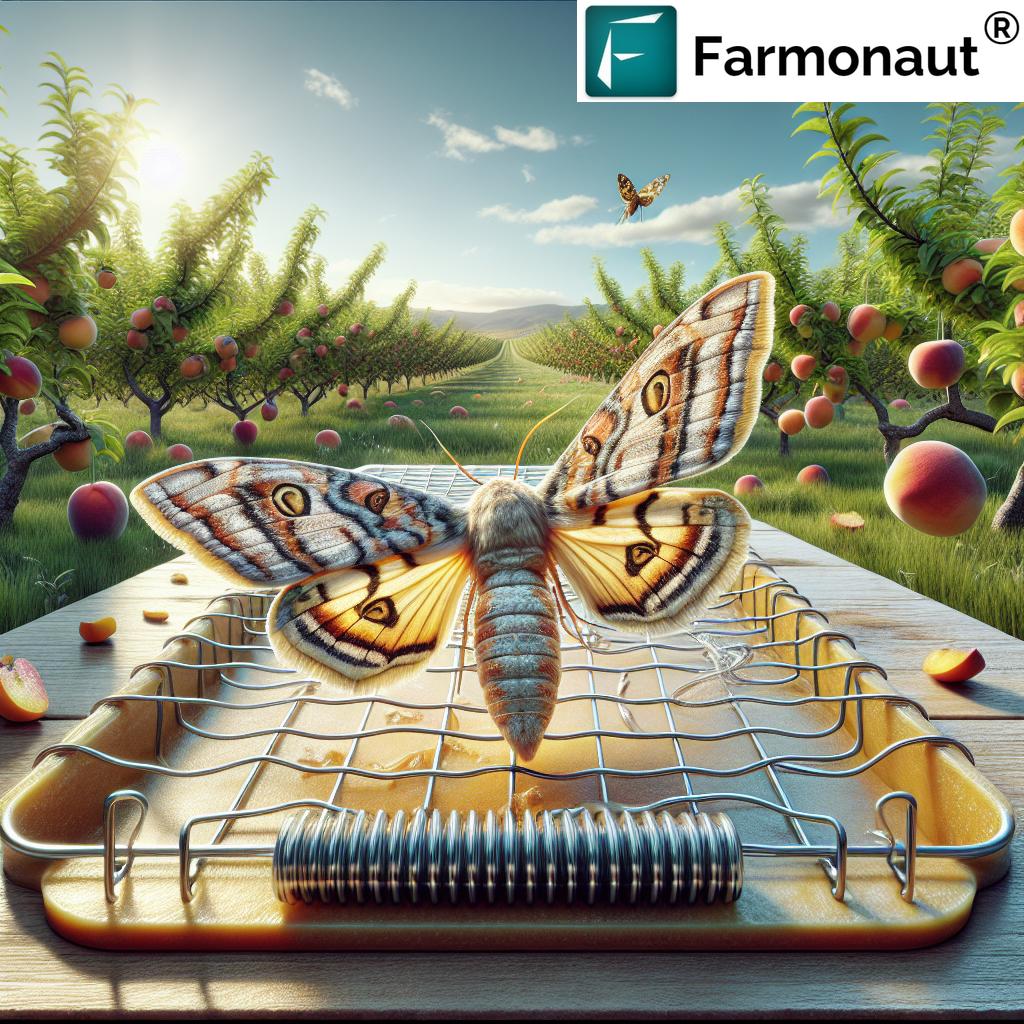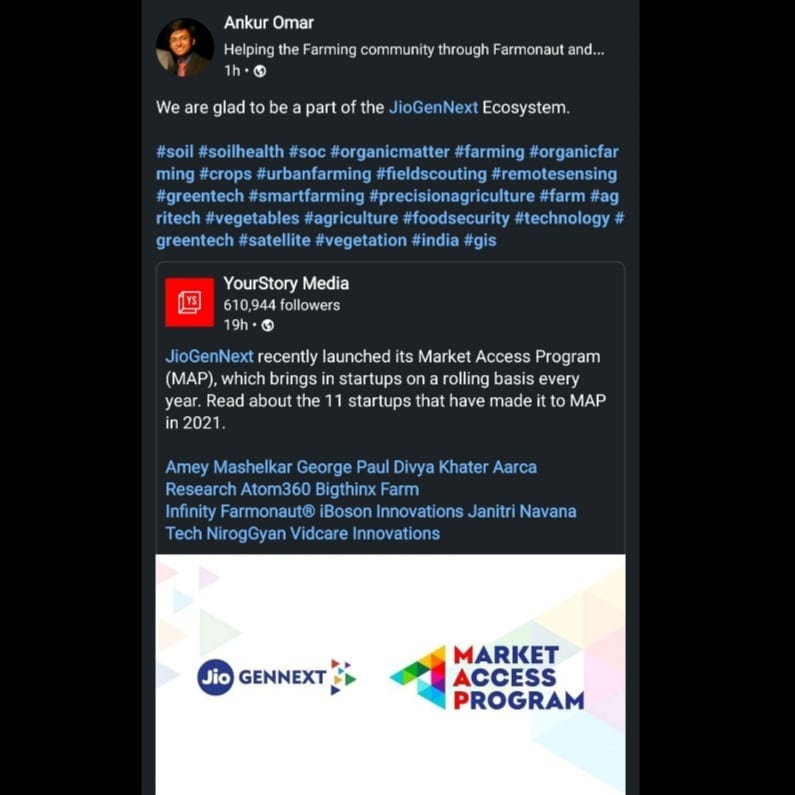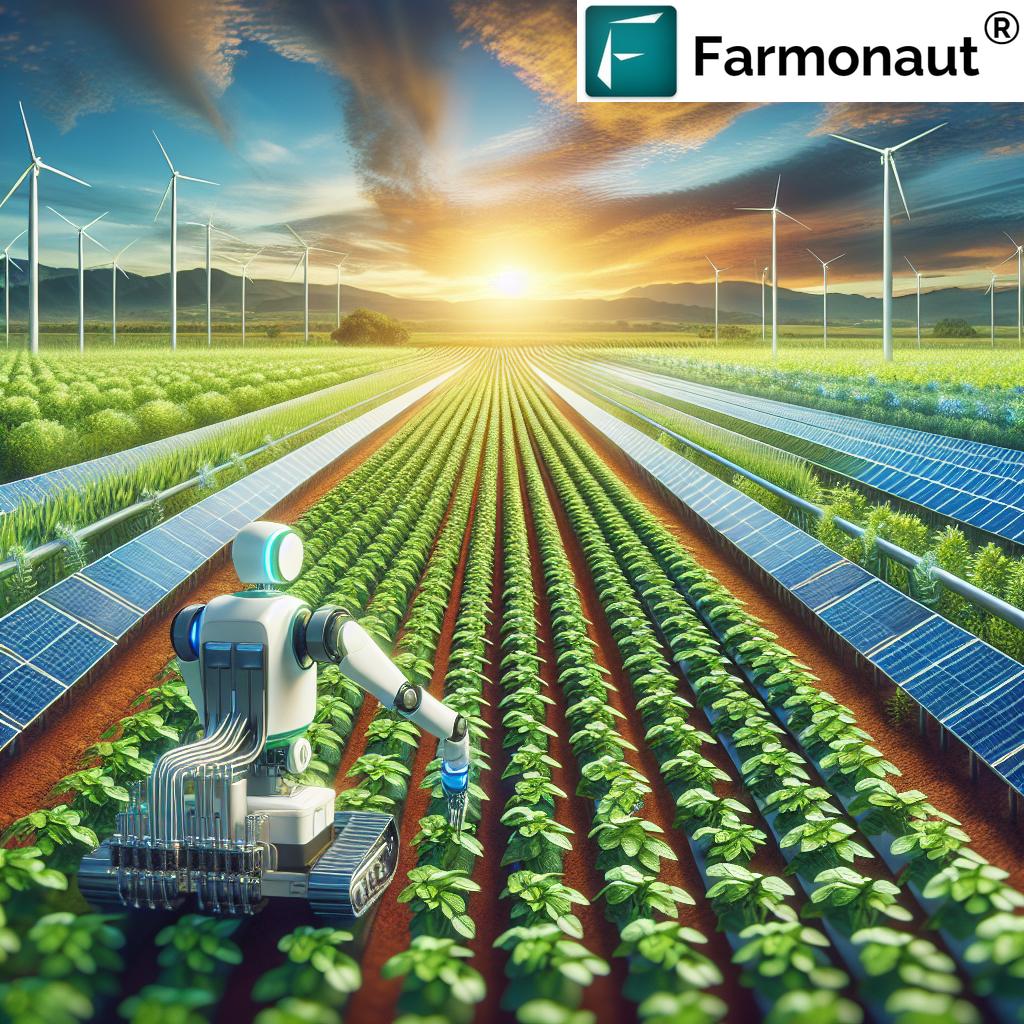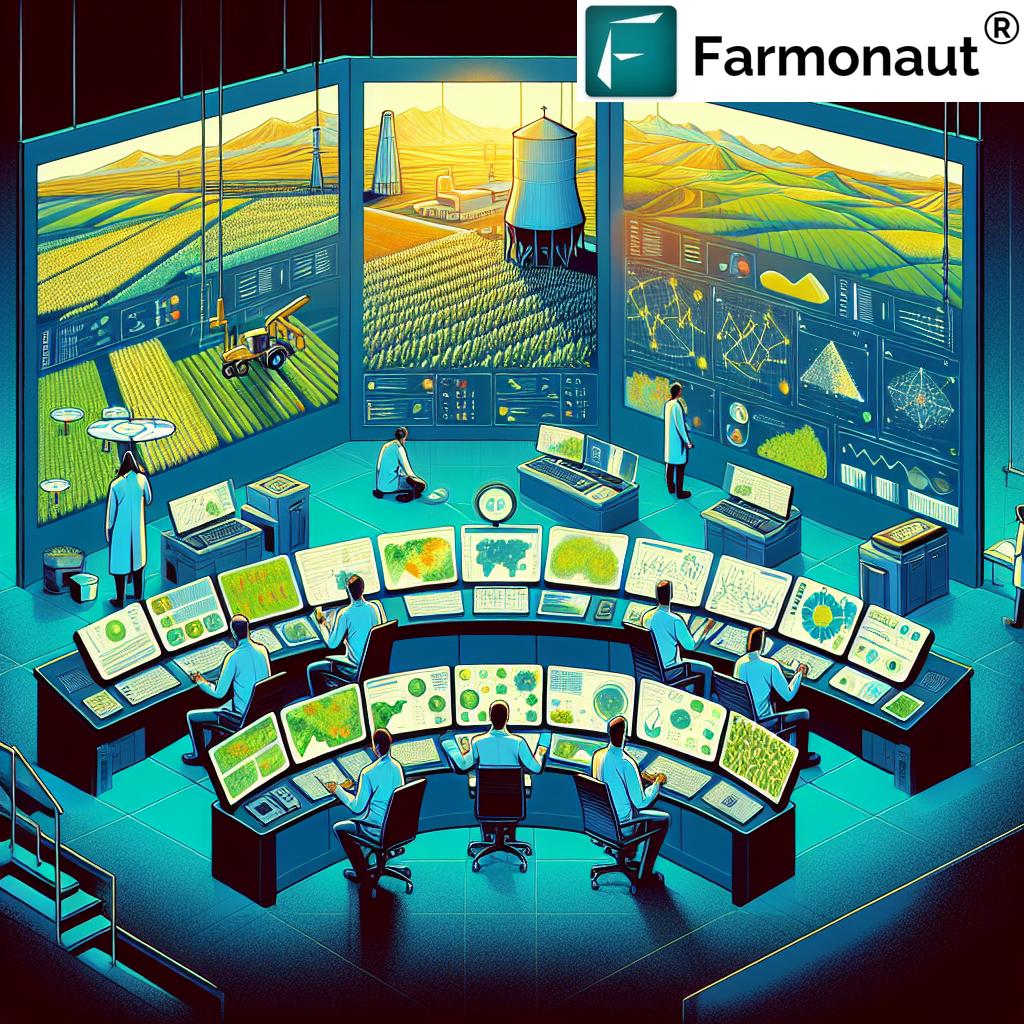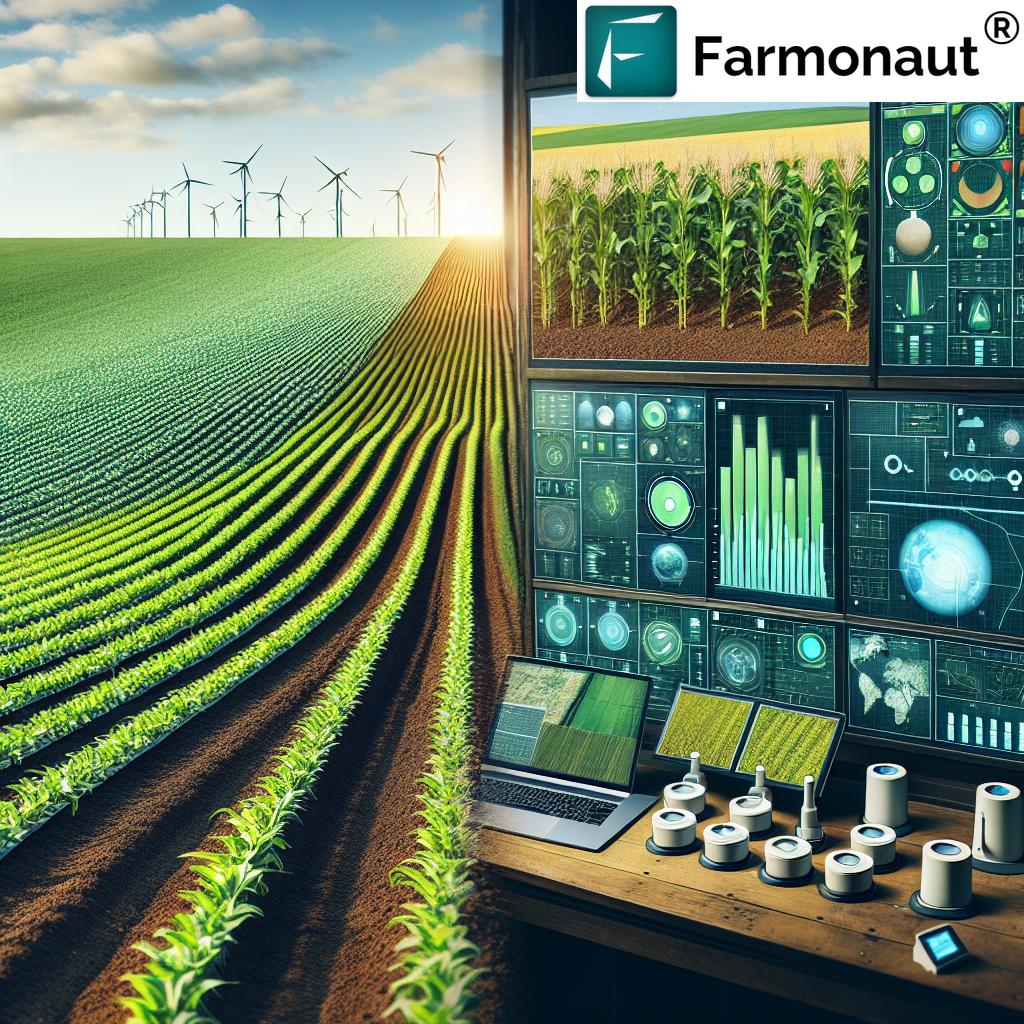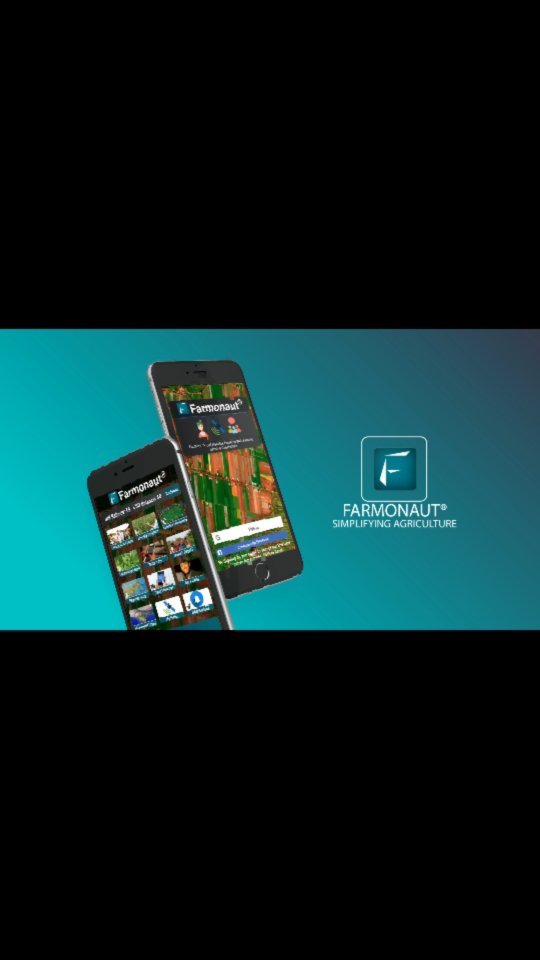Smart Farming IoT in Agriculture: 7 Yield Hacks!
“Over 75% of smart farms use IoT sensors for real-time soil and crop monitoring.”
Summary: Smart Farming – Harnessing IoT for Agricultural Advancement
The integration of IoT in agriculture—commonly referred to as smart farming—is revolutionizing traditional farming. By embedding sensors, devices, and connectivity into agricultural processes, we’re seeing a shift to data-driven farming, optimized resource management, and remarkable improvements in productivity and sustainability. Advanced IoT solutions—ranging from farm monitoring systems to precision agriculture applications—enable us to make informed decisions and adopt sustainable agricultural practices, securing greater yields and efficiency for farms worldwide.
Farmonaut’s advanced farm management platform leverages satellite, AI, and blockchain technologies to make precision agriculture both affordable and accessible—empowering everyone from smallholders to large agribusinesses.
What is Smart Farming? The Role of IoT in Agriculture
Smart farming, or precision agriculture, is a game-changer for global agriculture. At its core, it involves the use of the Internet of Things (IoT)—a network of connected devices and sensors that gather and analyze data to boost farm productivity. These agricultural IoT devices generate real-time information on everything from soil health and crop growth to weather conditions, enabling us to make smarter agricultural decisions.
- IoT devices such as sensors, weather stations, and drones collect critical data on the health and status of crops and livestock.
- Cloud platforms and data analytics turn raw data into actionable insights, helping us optimize irrigation, fertilization, and pest control.
- Automated systems reduce manual labor and streamline farm operations for better efficiency and resource utilization.
The emergence of IoT in agriculture makes it possible to farm more efficiently, conserve resources like water, and reduce environmental impact—all while maximizing yields and profitability.
Why IoT is the Key to Modern Farming
Let’s not forget—global population growth and climate uncertainties threaten traditional ways of farming. IoT-driven solutions provide a sustainable path forward, ensuring that we can produce more food with less waste and lower resource input. Smart farming is our roadmap to resilient, future-ready agriculture.
How IoT Devices Are Revolutionizing Modern Agriculture
We are witnessing a transformation of agricultural practices worldwide, fueled by a new breed of IoT devices and cloud-based platforms. Here’s how these devices work their magic:
- Data Gathering: Sensors installed in fields measure soil moisture, temperature, pH, nutrient content, and more.
- Connectivity & Integration: Devices communicate asynchronously through internet-connected networks, often powered by solar or battery technology for remote locations.
- Data Transmission & Analysis: Data is relayed to the cloud, where advanced analytics and AI among them solutions like Farmonaut’s Jeevn AI transform raw readings into actionable insights.
- Automated Action: Systems can trigger irrigation pumps, send fertilizer schedules, or notify us when pests are detected—all with minimal human intervention.
The integration of IoT with other technologies like carbon footprint monitoring and blockchain-based product traceability makes modern agriculture not just smart, but also transparent, secure, and sustainable.
- Real-time monitoring (via farm monitoring systems) enables swift responses to issues, minimizing losses and maximizing yields.
- Resource management becomes far more efficient—think less wasted water, reduced fertilizer and pesticide use, and lower costs.
- Remote diagnostics streamline farm operations, allowing us to manage multiple fields or even entire agribusinesses from anywhere via apps.
Through IoT, data-driven farming becomes achievable for everyone—from local farmers in rural areas to large-scale agribusinesses.
“Precision agriculture with IoT can reduce water usage by up to 30% in modern farms.”
7 Yield Hacks: Precision Agriculture Solutions with IoT
Let’s explore the seven most transformative IoT-powered yield hacks. These precision agriculture solutions are shaping farms into smarter, more efficient, and more productive systems.
-
Soil and Crop Monitoring with IoT Sensors
- IoT sensors in fields continuously measure soil moisture levels, temperature, pH, and nutrient content.
- Farmers receive data on optimal irrigation, fertilization, and planting schedules, improving crop growth conditions.
- Early alerts for soil anomalies help prevent reduced yields or crop failure.
-
Precision Input Management: Water, Fertilizer & Pesticide
- By analyzing sensor data, we can apply water, fertilizers, and pesticides precisely—targeted to each plant or field zone.
- This ensures optimized input use, reducing waste and environmental impact.
- The result? Higher yields, lower costs, and a more sustainable approach to farming.
-
Livestock Monitoring Technology for Health and Yield
- IoT-based wearables and sensor collars monitor livestock health, location, and behavior in real-time.
- Automatic detection of abnormal patterns helps us act swiftly against diseases or stress.
- Optimized feeding schedules and environment management improve productivity and animal welfare.
-
IoT-Based Smart Irrigation Systems
- Farm monitoring systems gather moisture and weather data to automate irrigation schedules at optimal times.
- Reduces overwatering and water scarcity; ensures crops always receive what’s needed, when needed.
-
Supply Chain Traceability & Transparency with IoT
- IoT and blockchain create auditable trails for produce—tracking agricultural products from farm to market.
- Consumers and retailers can verify product origin, ensuring quality, control, and consumer trust.
- This technological leap reduces fraud and increases pricing power for verified products.
-
Weather & Climate Smart Monitoring Solutions
- Field weather stations deliver hyper-local weather conditions and forecasts, empowering data-driven actions for planting, irrigation, and harvesting.
- Integration with AI tools (like Farmonaut’s Jeevn AI) provides customized advisories per field or crop variety.
-
Automated Drones and Imagery
- IoT-enabled drones monitor crop health, assess pest pressure, and support variable-rate applications.
- Capture high-resolution images for analysis—identifying disease, nutrient deficiency, or water stress early on.
- Drones automate repetitive tasks and provide valuable insights for large-scale operations.
Why These Hacks Matter
- Smart monitoring and automation ensure we are always a step ahead, maximizing output and minimizing risk in both crops and livestock.
- Sustainable agriculture practices become realistic, helping us conserve vital resources and protect the environment for future generations.
- Data integration means better large-scale farm management, especially when combined with platforms like Farmonaut, that provide real-time satellite intelligence for big or distributed operations.
Comparative Impact Table on Smart Farming IoT Applications
| IoT Solution | Estimated Yield Improvement (%) | Resource Savings (Estimated %) | Key Benefit | Typical Application Area |
|---|---|---|---|---|
| Soil Moisture Sensors | 15–20% | 10–15% less water | Enhanced irrigation efficiency | Row crops & vegetables |
| Automated Drones & Aerial Monitoring | 10–18% | 5–10% reduction in input waste | Precision scouting & disease detection | Large field crops, orchards |
| IoT-Based Irrigation Systems | 12–25% | 20–30% less water | Water conservation | All irrigated farms |
| Livestock Monitoring Technology | 10–15% | 5–10% less feed wastage | Early disease detection | Dairy & beef operations |
| Blockchain Traceability | 5–10% (via market access) | – | Consumer trust & premium pricing | Export crops, perishables |
| Field Weather Stations & AI Advisory | 8–12% | 5–10% input optimization | Timely, predictive decisions | All farms |
| Automated Input Management | 10–16% | 12–18% less fertilizer/pesticide | Reduced waste & costs | Crop fields, greenhouse |
As illustrated in the above table, each IoT yield hack drives significant gains in yield, cost, efficiency, and sustainability—across diverse agricultural environments.
Farmonaut: Harnessing Satellite and AI for Precision Agricultural Advancement
Farmonaut represents a leap forward in improving farm productivity with IoT. Unlike traditional options, Farmonaut’s approach combines multispectral satellite imagery, AI-driven analytics, machine learning, and blockchain for seamless and actionable insight. Here’s how we empower farmers globally:
-
Satellite-Based Crop Health Monitoring:
- Real-time analysis of NDVI (Normalized Difference Vegetation Index) gives us the upper hand in measuring crop health, soil moisture, and vigor.
- Accessible via Android, iOS, Web apps, and browser—so you can monitor anywhere, anytime.
- Supports more efficient decisions for irrigation, fertilizer scheduling, pest management, and more.
-
Jeevn AI Advisory System:
- Delivers customized, field-specific recommendations based on continuous satellite and environmental data.
- Helps us pre-empt threats, recommend timely actions, and plan accurately for weather shifts.
-
Blockchain-Based Traceability Solutions:
- Offers fully transparent product tracking from farm to fork, enhancing food safety, supply chain control, and premium pricing opportunities.
- Consumer trust is built through a reliable, tamper-proof digital record—an essential factor in today’s global food market.
-
Fleet & Resource Management:
- Fleet management tools streamline the use of agricultural machinery, reduce downtime, and optimize on-field operations.
- Keep logistics and safety in-check, especially for large and multi-location agribusinesses.
-
Carbon Footprinting:
- Farmonaut’s carbon footprint tracking system provides real-time emissions data and actionable steps for meeting environmental goals.
- Embrace sustainable agriculture practices with ease; compliance with global environmental standards becomes achievable.
-
Crop Loan and Insurance Verification:
- Our satellite-based verification reduces crop loan fraud and expedites insurance claims—improving trust and access for farmers and lenders alike.
-
Scalable, API-Driven Platform:
- Integrate powerful agri-data into your own apps: Explore the Farmonaut satellite & weather API and see the developer docs.
Farmonaut is designed for everyone—individual growers, cooperatives, agribusinesses, and government agencies alike. You can scale its features as your needs grow, making it a robust partner for any venture.
Core Benefits of IoT in Agriculture
- Enhanced Productivity: Real-time farm data means we can act quickly—improving yields and livestock performance with every season.
- Resource Optimization & Cost Savings: Only the resources needed (water, fertilizer, pesticides) are used, drastically reducing waste and operational expenses.
- Environmental Sustainability: IoT in agriculture empowers us to adopt sustainable farming practices, minimizing chemical and water usage for a healthier ecosystem.
- Transparency & Trust: Traceability via blockchain helps both farmers and corporations verify product journeys—opening doors to premium markets and solidifying consumer loyalty.
- Adaptive Decision-Making: Access to AI-powered advisories (like those from Jeevn AI) keeps us ahead of weather shifts, pest threats, and changing field conditions.
- Improved Access to Financing: With tools like satellite-based verification, the loan and insurance process becomes easier, faster, and more reliable.
- Remote Management & Scalability: Oversee multiple fields, herds, or locations seamlessly—an absolute necessity for modern agribusinesses and government-led farming programs.
Platforms such as Farmonaut democratize access to these benefits, making precision agriculture solutions affordable even for small-scale farmers.
Common Challenges and Solutions in Adopting IoT for Smart Farming
While the benefits of smart farming are substantial, we must acknowledge and address several challenges to widespread adoption:
-
High Initial Investment: Many IoT devices and connectivity infrastructures represent a significant up-front cost, which can be difficult for smallholders.
- Solution: Technologies leveraging satellite data like Farmonaut, which require no on-field hardware, are bringing precision agriculture within reach for all.
-
Limited Connectivity in Rural Areas: Remote regions may struggle with spotty internet access, hindering real-time data transmission.
- Solution: Hybrid approaches (edge computing, low-bandwidth solutions) and partnerships with rural telcos are improving accessibility each year.
-
Data Security and Privacy Concerns: The volume of sensitive agricultural and personal data introduces vulnerability.
- Solution: Robust cybersecurity practices including end-to-end encryption and blockchain integration (as with Farmonaut’s platform) help ensure data privacy and protection.
-
Integration and Interoperability Challenges: IoT devices from different brands, platforms, or vendors can struggle to “talk to” each other.
- Solution: Cloud-first, modular solutions and open APIs—as provided by Farmonaut—enable easy integration and scalability.
By focusing on affordable, scalable, and secure solutions, we can overcome these barriers—and unlock smart farming for farmers everywhere.
Next-Gen Trends: The Future of IoT in Agriculture
The journey of IoT in agriculture is just beginning! Let’s look at the trends shaping tomorrow’s smart farms:
- Edge Computing & AI: More on-device data processing reduces reliance on cloud, speeding decisions and saving bandwidth.
- Affordable, Plug-and-Play IoT Devices: Lower-cost sensors and modular systems will boost adoption among smallholders worldwide.
- 5G Rural Connectivity: Next-gen wireless will make even remote fields part of the data-driven revolution.
- Increased “Green” Integration: Smart systems will measure, and help reduce, carbon footprints—aiding climate-positive farming and regulatory compliance.
- Greater Traceability: Blockchain and IoT will combine for end-to-end traceability, redefining food safety and supply chain transparency.
- Fully Automated Farms: With the rise of autonomous tractors, robotic drones, and continuous monitoring, we’re moving towards “farms of the future.”
Platforms like Farmonaut—with a focus on satellite, AI, and agro-specific blockchain—are leading the way towards these breakthroughs, ensuring that everyone has a stake in the future of farming.
Farmonaut: Affordable, Scalable Smart Agriculture for Everyone
Our mission at Farmonaut is to help you achieve more—using science, technology, and data-driven insights for every hectare, every field, and every farmer. Whether it’s a 1-acre orchard or a massive plantation, you can integrate precision agriculture into your workflow without the need for expensive on-field hardware.
- Subscription-based platform: Choose the service level that fits your needs, with clear, predictable pricing and world-class support.
- Seamless mobile and API access: Track, monitor, and manage your farm wherever you are—in the field or at your desk.
- Supporting governments, agribusinesses, and smallholders alike: Flexible and highly scalable—from a single farm to thousands at once.
- Boost your sustainability, profitability, and transparency—all in one place.
Take the first step towards data-driven, sustainable agriculture with Farmonaut today:
FAQ – Smart Farming & IoT in Agriculture
What is smart farming and how does it use IoT?
Smart farming is the application of modern information and communication technologies—primarily the Internet of Things (IoT)—to agriculture. It leverages IoT devices such as sensors, drones, and cloud platforms to collect real-time data on farms, enabling farmers to optimize operations, improve productivity, and minimize resource use, all while ensuring sustainability.
What are the main benefits of IoT in agriculture?
The primary benefits include real-time farm monitoring, data-driven decision-making, optimized resource management (less water, fertilizer, and pesticides), improved yields, reduced costs, and greater transparency in the supply chain. IoT solutions also foster sustainable agriculture practices and better risk management.
What types of IoT devices are used in farming?
Common IoT devices in agriculture include soil moisture sensors, weather stations, crop health sensors, livestock monitoring wearables, drones for aerial imaging, automated irrigation systems, and platforms for supply chain traceability using blockchain.
Can IoT-based smart farming work in rural areas with poor connectivity?
While reliable internet access is crucial for traditional IoT systems, innovations like satellite-based platforms (such as Farmonaut) and edge-processing solutions enable farmers in remote regions to access key benefits, even with limited connectivity.
How does blockchain improve traceability in agriculture?
Blockchain technology ensures that every transaction or movement in a product’s life cycle—from farm to consumer—is recorded in an immutable ledger. This guarantees transparency, reduces fraud, and builds consumer trust. Farmonaut’s blockchain-based traceability system is a great example, providing end-to-end verification.
Is smart farming only for large farms or rich farmers?
Not at all! Affordable, scalable solutions—especially satellite-based management like Farmonaut’s platform—allow smallholder farmers and cooperatives to access advanced precision agriculture without massive capital investment.
What are the main challenges in adopting IoT in agriculture?
The biggest barriers are often high upfront costs for hardware, connectivity gaps in rural areas, data security and privacy concerns, and integration problems between different platforms or devices. Cloud-based, modular, or satellite-driven solutions are steadily breaking down these obstacles.
How do I start using Farmonaut for smart farming?
Simply sign up on the Farmonaut Web App or download the Android/iOS apps. Choose a subscription level, and start monitoring your fields with satellite-based insights, AI advisories, and more.
Conclusion: The Smart Way Forward with IoT in Agriculture
The journey towards smart farming with IoT in agriculture marks the dawn of a new era for the world’s farms. From real-time soil and crop monitoring to end-to-end supply chain transparency, the possibilities with connected sensors, devices, and automated systems are endless.
Platforms such as Farmonaut are breaking down barriers to entry by providing affordable, scalable, and feature-rich solutions—extending the power of precision agriculture to everyone, everywhere. The future of farming is data-driven, sustainable, and efficient. Let’s harness these opportunities today and shape a healthier planet for tomorrow.


